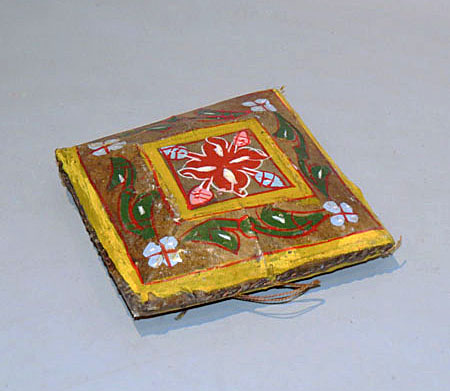
Owner: HWMC
Catalog#: AF-MBST-77-14
Berber ‘Adufe’ (frame drum)
Morocco
Berber
Wood, hide, fiber string, hard elements
Mid 20th Century
Length: 9 inches; Width: 9 inches
Membranophone – Struck (Directly) – Double-headed
This is a Berber hand-beaten wooden frame drum called adufe, from Morocco, Africa. The square wooden frame is covered with goat skin and is sewn around the perimeter with thick thread. Rattling elements are enclosed. The two sides of the adufe are hand-painted with geometric and floral decoration. These drums are of Muslim origin and are played in Iberia, Latin America, and North Africa. They are often used to accompany storytelling.
The Berber people are indigenous to North Africa occupying regions stretching from the Atlantic Ocean to the Mediterranean Sea. They speak the Berber language belonging to the Afroasiatic family. There are about 25-30 million Berber speakers in North Africa today with the majority found in Libya, Algeria, and Morocco. They are not entirely a homogeneous ethnicity but include a wide range of societies. Berber language, heritage, and history are considered the major unifying factors of the Berber people.
Most of the Berber people living in Morocco account for at least 35% of the population and in Algeria where they form, at least 15% of the population. A sizable number of Berbers are also found in Libya and Tunisia. Most of the North African Arabs also have a Berber ancestry. While the majority of the Berbers are Sunni Muslims, they still incorporate traditional practices in their worship. Traditional practices tend to dominate rural areas where Berbers outnumber the Arabs. Before conversion to Islam, some Berbers had converted to Christianity while others practiced polytheism.
Resource: Who Are the Berber People? – WorldAtlas
